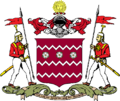| Emblem of Jammu and Kashmir | |
|---|---|
 | |
| Armiger | The Government of Jammu and Kashmir |
| Adopted | 31 October 2019 [1] |
| Shield | Lion Capital of Ashoka |
| Motto | Government of Jammu and Kashmir |
The Emblem of Jammu and Kashmir is an official symbol used to represent the government of Jammu and Kashmir, a region administered by India as a union territory.
Contents
Between 1947 and 2019, Jammu and Kashmir was administered as the State of Jammu and Kashmir. The state was reorganised into two union territories, Jammu and Kashmir and Ladakh, on 31 October 2019. The new union territory of Jammu and Kashmir has not as yet adopted a distinct symbol for official use and instead uses the words "Government of Jammu and Kashmir" on official documents either alone or in conjunction with the National Emblem of India. [2] [3] [4] [5]






